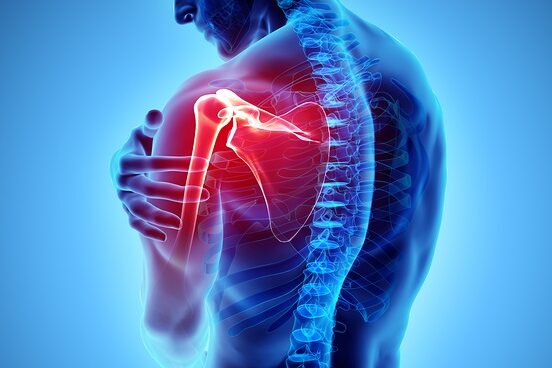Broken Shoulder
Written by Victoria Kerr Davis MCSP
This article is going to cover broken bones in the whole shoulder region which includes the shoulder blade (Scapula) collar bone (Clavicle) and the long bone of the upper arm called the Humerus.
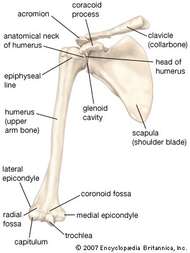
Scapula fractures:
The scapula is a triangular shaped bone which sits flush with the back wall of the chest, it consists of a body, the acromion, which together with the clavicle make the acromio-clavicular joint, a spine, a coracoid process and the glenoid fossa the interface which articulates with the humerus.
The Scapula is the base which allows for arm movement it attaches the upper limb to the chest, whilst the acromio-clavicular joint provides a strut keeping the arm at the side of the body.
Classification fractures of the scapula is in three groups.
Type 1 Fractures to the body
Type 2 Fractures of the Acromion, spine and coracoid process.
Type 3 Fractures of the Glenoid and anatomical and surgical scapular neck.
Fracture to the body is described as stellate, star shaped with radiating fissures running from the point of impact into the bone. Injuries to this bone which is protected by the chest and muscles are uncommon and usually caused by high impact trauma, road traffic accidents or riding.
Symptoms of this injury are pain, swelling, with possible localised tenderness and bruising, The arm is held close to the body, lifting the arm out to the side is painful.
Acromion fractures are characterised by pain on the tip of the shoulder, and difficulty moving the arm out to the side. Caused by downward blow to the point of the shoulder.
Coracoid fractures are felt on the front and the body side of the shoulder, caused by a direct blow or very strong pulling force, taking the arm into the body is painful as is lifting the arm with a bent elbow.
Glenoid and scapular neck fractures cause pain on all shoulder movement, the arm will be held into the side. This injury follows a fall onto a bent elbow, the force passing along the humerus directly to the Glenoid. Glenoid fractures may also be associated with shoulder dislocation.
Treatment
Type 1 Fractures are treated with sling/collar and cuff and due to the enveloping muscles the scapula is held in place with expected healing at 5 weeks.
Rehab will include physiotherapy to retrain scapula control and regain scapula-humeral patterns of movement. Hydrotherapy is a good adjunct to any rehab regime.
Type 2 Fractures can be treated conservatively if there is minimal displacement with a sling or collar and cuff.
Healing 3-4 weeks. If displaced and the function of the rotator cuff is compromised or there are other more complex associated injuries surgery my be considered, in this scenario a specific protocol will guide recovery.
Type 3 Fractures are treated case by case dependent on the mechanism and complexity of injury.
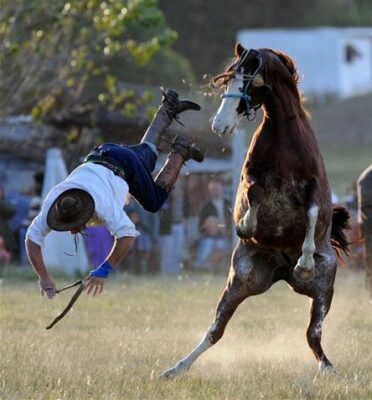
Clavicle fractures/ Collar bone
Cause: A fall or blow to the shoulder, very common in riding accidents.
Symptoms
Swelling and tenderness at injury site, usually mid clavicle and a visible step in the congruity of the bone, bruising, the shoulder drops and falls forward due to the loss of the bracing action of the clavicle which keeps the arm out to the side.
Treatment:
Usually conservative with sling/collar and cuff, sometimes figure of eight strapping, to hold the shoulder in its normal anatomical position and help to align the bone ends and aid union at the fracture site.
If there is marked displacement, or it is a compound injury where the fracture breaks the skin, surgery may be required with a plate and screws positioned to bridge the fracture and stabilise it whilst healing occurs.
What can I do?
Healing: 4 to 8 weeks and up to 12 weeks to full function, however you will all of heard of jockeys back in the saddle days after such an injury.
Initially it may be helpful to sleep in a more upright position.
Treatment
Ice packs for the swelling
Painkillers to control any pain.
Make sure to keep the elbow, wrist and fingers moving freely from day one.
At 2 weeks the fracture should show signs of healing a lump/thickening around the fracture site is to be expected and normal, at this stage start weaning yourself off the sling and increase movement of the arm aiming for full function at 12 to 16 weeks.
Exercising in water is a helpful option to aid recovery.
See Hydrotherapy for shoulders.
Shoulder Exercises in water-Hydrotherapy
Although the lump at the fracture site will reduce over the next few months it rarely completely disappears.
Complications: Non union in which case surgery will be considered to plate the fracture, to allow for healing.
Proximal Fractures of the Humerus
Cause: A fall, this type of fracture is the 3rd most common fracture in the over 65’s after the hip and wrist.
The injury site is just below the ball at the top of the upper arm, those with osteoporosis are particularly vulnerable to this injury.
Non displaced fractures- Most of these fractures 80% are non displaced and as such do not require surgery.
Displaced fractures– If however there is poor alignment the fracture is called displaced, dependant on how many parts of the proximal humerus are involved the fracture is graded. The parts to be considered are the greater and lesser tuberosities, the ball/humeral head and the humeral shaft, if there is a separation of more than 1cm or a rotation of more than 45 degrees or the the tuberosities which provide attachment for the all important rotator cuff muscles are involved surgery will be required.
Consideration will be given to achieving the best outcome given the persons age, their hand dominance, normal level of activity, the bone density, and the complexity of the injury. The options are plating, wire, screws, intramedullary nail, a replacement ball (hemiarthroplasty) a shoulder replacement conventional or the reverse shoulder replacement where the ball is attached to the scapula (shoulder blade) and the socket to the humerus.
Broken Shoulder Tips
Washing
You may remove the collar and cuff to wash. Wash under your arm using a hanging pendulum position.
Driving
You cannot drive whilst your arm is in a collar and cuff. You will not have free movement of your arm for several weeks after the sling has been removed. Therefore you will not be able to drive for at least eight weeks.
Work
This depends on your job. If you can work one-handed, you may be able to return to work two weeks after your injury. This also depends on you being able to get to work. If your job is manual you will be unable to work for at least three months.
Sport
In most cases, you may participate in light non-contact sports about six weeks after your injury. When you start playing, you will not be able to play for as long as normal. Your shoulder will ache at the end of exercises.
Smoking
You should not smoke whilst your fracture is healing. Research confirms that smoking slows down bone healing.
Treatment:
0-3 weeks
Non-displaced fractures are treated with collar and cuff worn continually from injury to up to 3 weeks, apart from caring for personal hygiene of the arm pit, the weight of the upper arm provides natural traction to hold the fracture in good alignment.
You must not put anything under your elbow in an attempt to support the weight of your arm. This would push your humerus upwards and move the bones into the wrong position. This is why you are not given a triangular sling. You must not rest your arm on a pillow when sitting or lying. You may wear it outside your clothes.
It may be helpful to sleep propped up in a more upright position.
During this time it is important to keep the muscles used for shoulder posture working. This is done by squeezing the shoulder blades together regularly and also be generally aware of posture.
Wrist and finger exercises are important to prevent the hand stiffening up. It is best to keep them moving through a full range of motion regularly.
It is also important to keep the elbow mobile. This can be done by keeping the upper arm into your side then elbow straighten and flex the elbow.
This can be combined with taking the arm out of the sling for washing under the arm. At the same time try turning the forearm to palm down palm up.
3-6 weeks:
Continue with the collar and cuff, but it can be removed several times a day for pendular exercises. These exercises are performed in standing leaning well forwards. Make sure you hold on to something with your uninjured arm to keep your balance.
With the injured arm hanging down like a pendulum with a relaxed elbow and hand swing the arm
1. Forwards and backwards
2. Gently out to the side and back in
3. Then make small circles clockwise and anticlockwise.
At this time you can also start auto assisted exercises up to shoulder height only where you support your injured arm with your non injured arm .
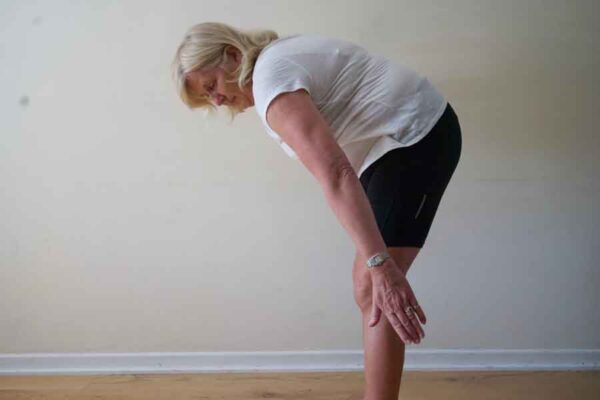
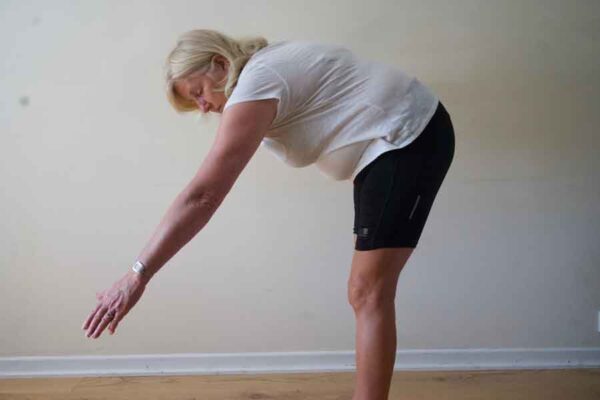
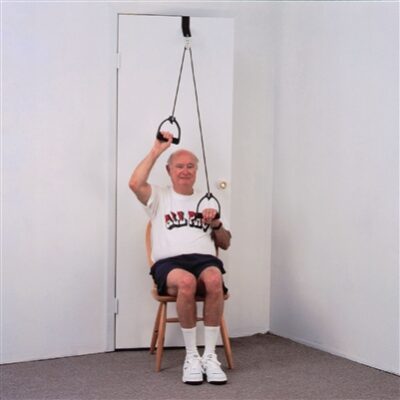
6-12 weeks:
At this point the fracture is largely healed however the arm will feel weak and heavy with a limited range of movement.
You can start to wean yourself off wearing the sling
Now you can start active exercises to increase range of movement and muscle strength.
Return to normal light activities are encouraged.
Exercises such as lifting the arm overhead, initially in lying with the support of the other arm, and then in standing holding them together or holding a stick/pole.
A good exercise to mobilize the shoulder is to put your hands on a work surface and then walking backwards to stretch shoulder.
Another good exercise is to slide the hand up the wall
You can also rig up a pulley (easily bought on the internet) or cord over a door and use this to help stretch the bad arm up and down.
This is a great time to get into a pool to exercise the shoulder, the water takes the weight of the arm and helps with confidence, mobility and strength
see Hydrotherapy sheet for shoulders.
Shoulder Exercises in water-Hydrotherapy
see Exercise sheet for shoulder
Shoulder Exercises- mobilising exercises
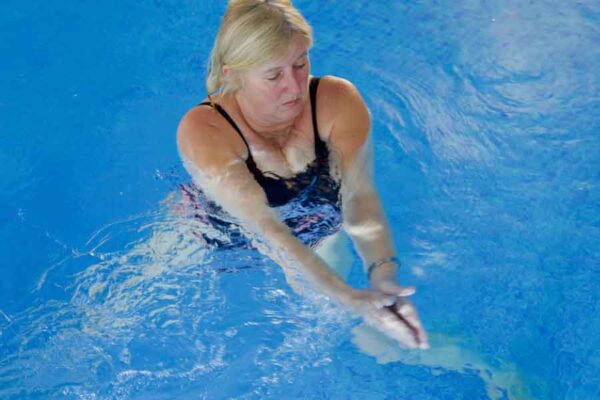
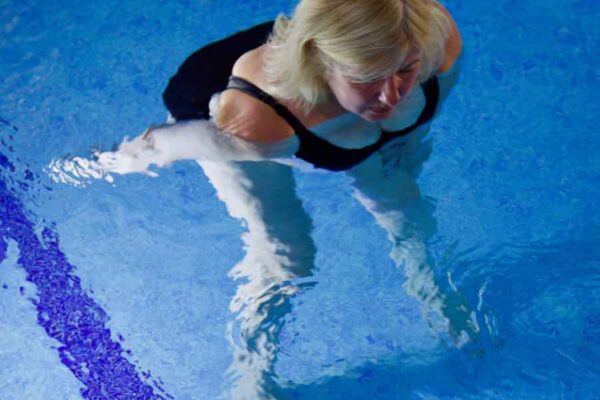
12 weeks to 3 months:
Full healing should be achieved now but the arm will not feel normal, it will tire, end of range movement may be compromised, however press on aiming for good functional movement.
It may well be 6 to 12 months before you feel the arm is a good as it can be, so do not give up too soon and aim for the best possible outcome.
Treatment after operative repair
The treatment following plating, wire, screws intramedullary nail will be similar to the above routine, advice regarding specific regimes will be given by the treating hospital.
Hemiarthroplasty, shoulder replacement or reversed shoulder replacement will be covered by the surgeon’s protocol.
Hydrotherapy remains an option here too.
Complications: Non union which will require a surgical option.
Decreased strength, decreased mobility, subsequent arthritis.

